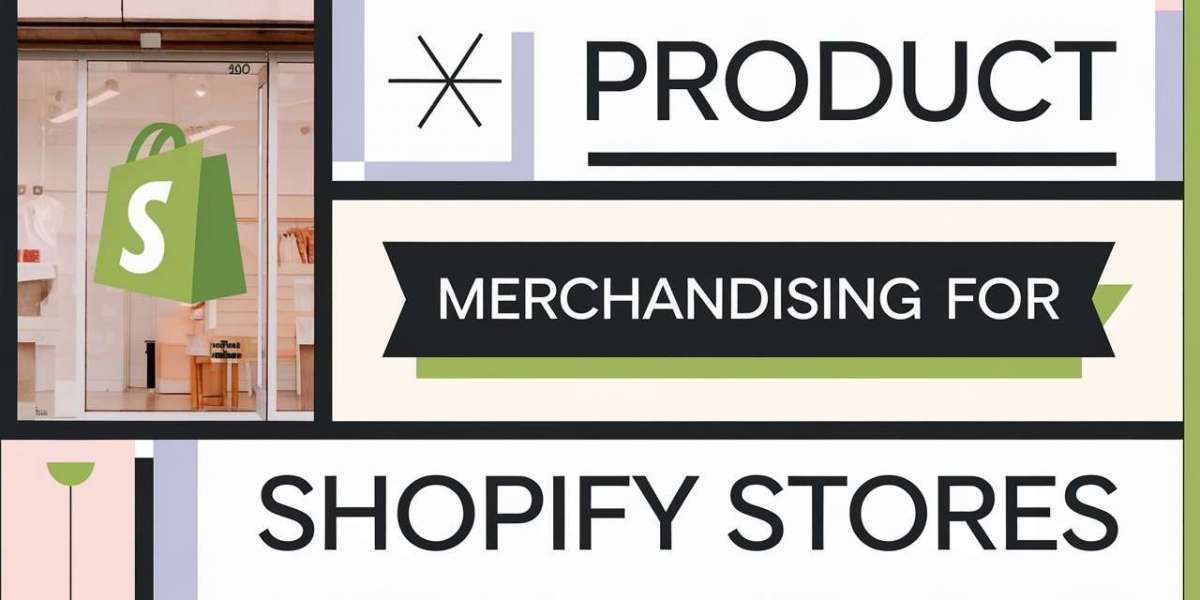Product merchandising is the art of presenting products in a way that attracts customers and drives sales. For Shopify store owners, effective product merchandising is crucial in 2024, as the eCommerce landscape becomes increasingly competitive. This guide will walk you through everything you need to know about product merchandising for Shopify stores, from basic strategies to advanced techniques.
If you’re looking to boost your store’s sales and create an engaging shopping experience, mastering product merchandising is essential. To ensure the best results, you may want to hire a professional Shopify developer who can customize your store’s features to enhance merchandising efforts.
Understanding the Importance of Product Merchandising
Product merchandising is more than just arranging products on your store’s pages; it’s about telling a story that resonates with your customers. Good merchandising can make the difference between a visitor leaving your store or making a purchase.
Enhanced User Experience: A well-merchandised store makes it easier for customers to find what they’re looking for.
Increased Sales: Effective product presentation can highlight bestsellers and new arrivals, driving more conversions.
Brand Identity: Consistent and strategic merchandising reinforces your brand’s identity and values.
Key Strategies for Effective Product Merchandising
Effective product merchandising involves more than just displaying products; it's about strategically positioning them to maximize visibility and appeal. Here are some key strategies to help you make the most of your product offerings on Shopify:
a. Highlight Bestsellers and New Arrivals
Place your best-selling products and new arrivals front and center on your homepage. This draws immediate attention to the items most likely to convert.
Use bold headings and eye-catching images to make these products stand out.
b. Utilize Cross-Selling and Upselling Techniques
Encourage customers to buy complementary products by displaying related items on product pages. For example, if a customer is viewing a shirt, suggest matching pants or accessories.
Upselling involves recommending higher-end versions of a product the customer is considering, which can increase the average order value.
c. Create Curated Collections
Organize products into collections based on themes, seasons, or customer preferences. This helps customers easily find what they're looking for and encourages them to explore more.
Collections like "Summer Essentials" or "Holiday Gift Guide" can be particularly effective.
d. Leverage User-Generated Content
Showcase customer reviews, photos, and testimonials on product pages. This builds trust and provides social proof, making potential buyers more likely to make a purchase.
Encourage satisfied customers to share their experiences on social media and tag your store.
e. Optimize Product Descriptions and Titles
Write clear, concise, and compelling product descriptions that highlight key features and benefits. Use italic text to emphasize unique selling points.
Include relevant keywords in product titles and descriptions to improve your store’s search engine rankings.
How to Implement Product Merchandising in Your Shopify Store
Implementing effective product merchandising in your Shopify store involves a combination of strategic planning and the use of Shopify's built-in tools and third-party apps. Here's a step-by-step guide to help you get started:
a. Set Up Collections and Categories
Start by organizing your products into relevant collections and categories. This will make it easier for customers to navigate your store and find what they’re looking for.
Use Shopify's Collection feature to group products based on themes, seasons, or customer preferences.
b. Customize Your Store’s Layout
The layout of your store plays a crucial role in product merchandising. Ensure that your homepage, product pages, and collection pages are designed to highlight key products.
Consider using Shopify's drag-and-drop editor to customize the layout, making it easy to showcase bestsellers, new arrivals, and promotional items.
c. Optimize Product Pages
Each product page should be optimized with high-quality images, compelling descriptions, and clear call-to-action (CTA) buttons.
Use bold text to highlight important information like product features, availability, and pricing.
d. Implement Cross-Selling and Upselling
Shopify allows you to add sections like "You May Also Like" or "Customers Also Bought" on product pages to encourage cross-selling.
For upselling, you can add a "Compare" feature or recommend premium versions of the products being viewed.
e. Leverage Shopify Apps
There are numerous apps available in the Shopify App Store that can enhance your merchandising efforts. For example, apps like Bold Upsell or Frequently Bought Together can automate cross-selling and upselling.
Consider using apps that allow for dynamic pricing, bundling products, or displaying customer reviews to enhance the shopping experience.
f. Test and Optimize
Regularly test different merchandising strategies and layouts to see what resonates most with your audience. Use A/B testing to compare different versions of product pages, collections, or CTAs.
Analyze data from Shopify’s built-in analytics tools to make informed decisions and continuously improve your merchandising approach.
Best Practices for Optimizing Product Displays
Optimizing your product displays is essential for capturing customer attention and encouraging them to make a purchase. Here are some best practices to help you create visually appealing and effective product displays in your Shopify store:
a. Use High-Quality Images
Visual appeal is key: Ensure all product images are high resolution, and well-lit, and showcase the product from multiple angles.
Include zoom functionality so customers can see the details of your products up close.
Consider adding lifestyle images that show the product in use, helping customers envision how the product will fit into their lives.
b. Consistent Image Sizes and Ratios
Maintain consistent image sizes and aspect ratios across your store to create a clean, professional look. This consistency helps to avoid a cluttered or disorganized appearance.
Shopify allows you to standardize image sizes, making it easier to create a cohesive visual experience.
c. Showcase Product Variations
If your products come in different colors, sizes, or styles, make sure these variations are prominently displayed.
Use swatch options or dropdown menus to allow customers to easily select their preferred variation.
d. Highlight Key Product Features
Use bold text to highlight essential product features and benefits in the description.
Consider using icons or bullet points to make key information easily understandable.
e. Create a Sense of Urgency
Incorporate elements that create a sense of urgency, such as limited-time offers, countdown timers, or low-stock alerts. This can encourage customers to make a purchase more quickly.
Highlight any ongoing promotions or discounts on product pages with bold and eye-catching colors.
f. Add Product Videos
Videos can be a powerful tool for showcasing products in action. Add short, high-quality videos that demonstrate how the product works, its features, and its benefits.
Shopify makes it easy to embed videos directly onto product pages, enhancing the overall shopping experience.
g. Incorporate Social Proof
Display customer reviews, ratings, and testimonials prominently on product pages. Social proof builds trust and can significantly influence purchasing decisions.
If possible, include user-generated content, such as customer photos or videos, to show real-world usage of your products.
Tools and Apps to Enhance Product Merchandising
Leveraging the right tools and apps can take your product merchandising efforts to the next level, making your Shopify store more dynamic and user-friendly. Here are some must-have tools and apps that can help you optimize product merchandising:
a. Product Filter & Search by Boost Commerce
This app enhances your store's search and filtering capabilities, allowing customers to easily find products based on various criteria like price, color, size, or brand.
The app also supports merchandising by enabling custom product rankings and sorting options, ensuring that your bestsellers or promotional items appear first.
b. Bold Upsell
Bold Upsell is an excellent tool for cross-selling and upselling. It allows you to offer additional products or upgrades at the point of purchase, increasing your average order value.
With this app, you can set up targeted offers based on what the customer has added to their cart, making the upsell more relevant and enticing.
c. Loox – Photo Reviews
Loox helps you build trust with potential customers by displaying photo reviews from existing customers. Visual testimonials can significantly impact purchasing decisions.
The app also integrates with your product pages to showcase these reviews prominently, enhancing the credibility of your merchandise.
d. PageFly Landing Page Builder
PageFly is a drag-and-drop page builder that allows you to create custom landing pages, product pages, and home pages without needing to code.
You can use this app to design unique layouts that highlight your products effectively, improving the overall user experience.
e. Klaviyo – Email Marketing
Klaviyo is a powerful email marketing tool that can be used to promote your products through targeted campaigns. You can segment your audience based on their shopping behavior and send personalized product recommendations.
This app also allows you to create automated flows for product launches, seasonal promotions, and abandoned cart reminders, driving more sales through effective merchandising.
f. Frequently Bought Together
This app analyzes your store’s sales data to identify products that are often purchased together. It then displays these items on product pages as a bundle, encouraging customers to buy more.
By offering relevant product combinations, you can boost your store’s overall sales and improve the customer shopping experience.
g. Shopify POS (Point of Sale)
If you have a physical store as well, Shopify POS allows you to manage in-store and online inventory seamlessly. This integration ensures that your merchandising strategies are consistent across all sales channels.
With Shopify POS, you can offer in-store pickup options, real-time inventory updates, and a unified shopping experience for your customers.
Why You Should Hire a Professional Shopify Developer
While Shopify provides a robust platform with numerous built-in features and third-party apps, optimizing your store’s product merchandising can sometimes require more advanced customization and technical know-how. Here’s why hiring a professional Shopify developer can make a significant difference in your store’s success:
a. Custom Solutions Tailored to Your Needs
A professional Shopify developer can create custom solutions that are specifically tailored to your store’s unique needs. Whether it’s designing a bespoke theme, implementing complex filtering options, or integrating third-party tools, a developer can ensure everything works seamlessly together.
Customization allows your store to stand out from the competition, providing a unique shopping experience that aligns with your brand.
b. Advanced Functionality and Integrations
Developers can integrate advanced functionalities that go beyond the standard Shopify capabilities. This includes custom product recommendations, dynamic pricing models, and personalized shopping experiences based on customer data.
If you need to connect your Shopify store with external systems like CRM, ERP, or custom APIs, a professional developer can handle these integrations smoothly.
c. Improved Store Performance
Speed and performance are critical for online stores. A professional Shopify developer can optimize your site’s performance, ensuring fast load times and a smooth user experience, which are essential for reducing bounce rates and improving SEO.
Developers can also implement performance-enhancing techniques like lazy loading, image optimization, and code minification to make sure your store runs efficiently.
d. Ongoing Support and Maintenance
E-commerce trends and technologies are constantly evolving. Having a professional developer on your team means you’ll have access to ongoing support and maintenance, ensuring your store stays up-to-date with the latest features and security updates.
This ongoing partnership can help you quickly adapt to new opportunities, address any technical issues, and continuously improve your store’s merchandising strategies.
e. Focus on Your Business
Hiring a professional Shopify developer allows you to focus on what you do best—running your business. You can leave the technical aspects to the experts, freeing up your time to concentrate on product sourcing, marketing, and customer service.
With a developer handling the technical details, you can be confident that your store is in good hands, allowing you to scale your business without worrying about technical challenges.
Conclusion
Product merchandising is a critical component of running a successful Shopify store. By strategically presenting your products, you can enhance the shopping experience, boost sales, and build a strong brand identity. Whether you’re a seasoned eCommerce entrepreneur or just starting, understanding and implementing effective merchandising techniques will help you stay competitive in 2024 and beyond.
From organizing products into collections to using high-quality images and leveraging tools like cross-selling and upselling apps, there are numerous strategies you can employ to optimize your store. Additionally, hiring a professional Shopify developer can be a game-changer, offering you the customization, advanced functionality, and ongoing support needed to elevate your store to new heights.







